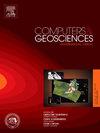Efficient computation on large regular grids of higher-order spatial statistics via fast Fourier transform
IF 4.4
2区 地球科学
Q1 COMPUTER SCIENCE, INTERDISCIPLINARY APPLICATIONS
引用次数: 0
Abstract
The complex spatial structures of natural variables are often caused by geological, physicochemical, meteorological, and biological processes that have shaped the emergence of the fields. The typical prediction of the spatial distributions of these phenomena is based on second-order geostatistical models. However, this approach has limitations, given the high complexity, non-Gaussian distributions, and nonlinear spatial connectivity models inherent in geological systems. Recently, researchers have suggested using higher-order spatial statistics, based on two- and three-point spatial statistics, to better capture spatial phenomena. Nevertheless, applying these methods requires intense numerical calculations, particularly in the case of extensive geostatistical models, and becomes especially intricate when utilized for conditioning realizations, such as in inverse problems. Spatial asymmetries and higher-order spatial cumulants, as well as their generalizations, are important higher-order statistics for characterizing non-Gaussian features. In this study, we focus on third-order statistics derived from two- and three-point spatial statistics. A MATLAB program has been developed to compute efficiently these spatial statistics using the FFT algorithm. The overall approach of these programs draws inspiration from the method successfully used for the fast calculation of variograms and cross-covariances using FFT. We recall the methodology associated with the computation of direct- and cross-variograms using FFT, as well as transiograms for categorical data. Codes are created to process regular grid data, whether it is complete or incomplete. Post-processing tools have been added to help geomodelers visualize the results. Using the FFT method is faster and delivers the same results as conventional spatial methods for this type of data. These programs are particularly valuable tools for geostatistical modeling and estimation when higher-order statistics are present in the spatial structures of natural variables, providing an efficient solution to the computational challenges associated with such applications.
基于快速傅里叶变换的高阶空间统计量大规则网格的高效计算
自然变量的复杂空间结构通常是由地质、物理化学、气象和生物过程引起的,这些过程塑造了这些领域的出现。这些现象的空间分布的典型预测是基于二阶地统计模型。然而,考虑到地质系统固有的高复杂性、非高斯分布和非线性空间连通性模型,这种方法存在局限性。最近,研究人员建议使用基于两点和三点空间统计的高阶空间统计来更好地捕捉空间现象。然而,应用这些方法需要大量的数值计算,特别是在广泛的地质统计模型的情况下,并且在用于条件实现时变得特别复杂,例如在反问题中。空间不对称和高阶空间累积量及其推广是表征非高斯特征的重要高阶统计量。在本研究中,我们重点研究了由两点和三点空间统计导出的三阶统计量。开发了一个MATLAB程序,利用FFT算法有效地计算这些空间统计量。这些程序的总体方法从使用FFT成功地快速计算变差和交叉协方差的方法中获得灵感。我们回顾了使用FFT计算直接变差和交叉变差的方法,以及分类数据的透射图。创建代码是为了处理规则的网格数据,无论它是完整的还是不完整的。添加了后处理工具来帮助地质建模者可视化结果。对于这种类型的数据,使用FFT方法更快,并且提供与传统空间方法相同的结果。当高阶统计数据存在于自然变量的空间结构中时,这些程序是地质统计建模和估计的特别有价值的工具,为与此类应用相关的计算挑战提供了有效的解决方案。
本文章由计算机程序翻译,如有差异,请以英文原文为准。
求助全文
约1分钟内获得全文
求助全文
来源期刊

Computers & Geosciences
地学-地球科学综合
CiteScore
9.30
自引率
6.80%
发文量
164
审稿时长
3.4 months
期刊介绍:
Computers & Geosciences publishes high impact, original research at the interface between Computer Sciences and Geosciences. Publications should apply modern computer science paradigms, whether computational or informatics-based, to address problems in the geosciences.
 求助内容:
求助内容: 应助结果提醒方式:
应助结果提醒方式:


